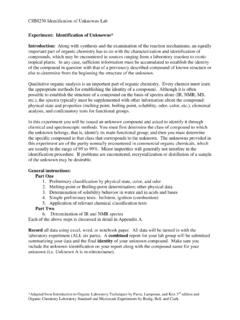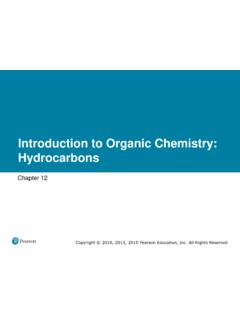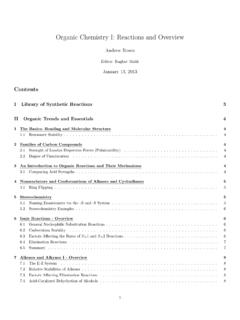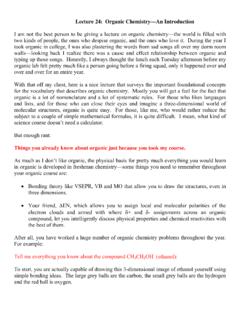Transcription of 02: Introduction to Organic Chemistry - Rapid Learning Center
1 Rapid Learning Inc. All Rights Reserved Organic Chemistry - Core Concept Cheat Sheet 02: Introduction to Organic Chemistry Organic Chemistry Chemistry of Carbon Terminology Proper Structures Functional Groups Alkane: Contains a carbon-carbon single bond. CC Alkene: Contains a carbon-carbon double bond. CC Alkyne: Contains a carbon-carbon triple bond. CC Aromatic: Contains a six-membered ring, with alternating double and single bonds. Alkyl Halide: Contains an alkyl (alkane R) and a halogen, RX. Alcohol: Contains a ROH. Ether: Contains a ROR. Thiol: Contains RSH. Sulfide: Contains a RSR. Aldehyde: Contains a H bonded to a C on one side of a C=O and a R or H bonded to a C on the other side. COH Ketone: Contains 2 R groups attached to the C on either side of a C=O.
2 CORR Acid Halide: Contains a C=O, with an X attached to the C on one side and an R or H attached to the C on the other side. COX Carboxylic Acid: Contains a COOH, with an R or H attached to the C of the COOH. COOH Ester: Contains a COO, with an R attached to the O and a H or R attached to the C. COOR Anhydride: Contains an OCOCO, with an R or H attached on either side of the O. COOCO Amine: Contains an N, with R and / or H attached to the N. NR Amide: Contains a N attached to the C of a C=O, with H or R on the other positions. CON Nitrile: Contains a carbon nitrogen triple bond. NRC Acids and Bases Arrhenius Acid: Dissociates to give H3O+. Arrhenius Base: Dissociates to give OH. Bronsted-Lowry Acid: Donates an H+. Bronsted-Lowry Base: Accepts an H+. Conjugate Acid: acid that results from the Bronsted-Lowry base gaining an H+.
3 Conjugate Base: the base that results from the Bronsted-Lowry acid losing an H+. Amphoteric: Can react as an acid or a base. Lewis Acid: Accepts electron pairs to form new bonds. Lewis Base: Donates electron pairs to form new bonds. Electron Pushing Locate the electrons on the more electronegative atoms. Identify the most electronegative atom and the least electronegative atom in a bond. A mechanism is a step-by-step explanation of what happens in a chemical reaction. The flow of electrons in a mechanism is from the most electronegative atom to the least electronegative atom. The nucleophile donates the electrons in a mechanism. The electrophile accepts the electrons in a mechanism. Resonance structures are two or more equivalent structures for the same arrangements of atoms, the only difference is the location of the electrons.
4 Delocalization is the distribution of electrons among more than two atoms that are bonded together. CHHHNOOCHHHNOO How to Study Organic Chemistry For the terminology, know the definition of such terms as nucleophile, electrophile, syn, anti, etc. Learn the functional groups and be able to recognize them quickly. Learn the first ten alkanes, along with the prefixes and suffixes. Identify the most electronegative and the least electronegative atoms. The flow of electrons is from negative to positive. Understand the concepts, do not just memorize examples. Find examples in the textbook or on websites to reinforce the concepts. Make flashcards. Ask for help if you don t understand something. How to Use This Cheat Sheet: These are the keys related this topic. Try to read through it carefully twice then write it out on a blank sheet of paper.
5 Review it again before the exams.











